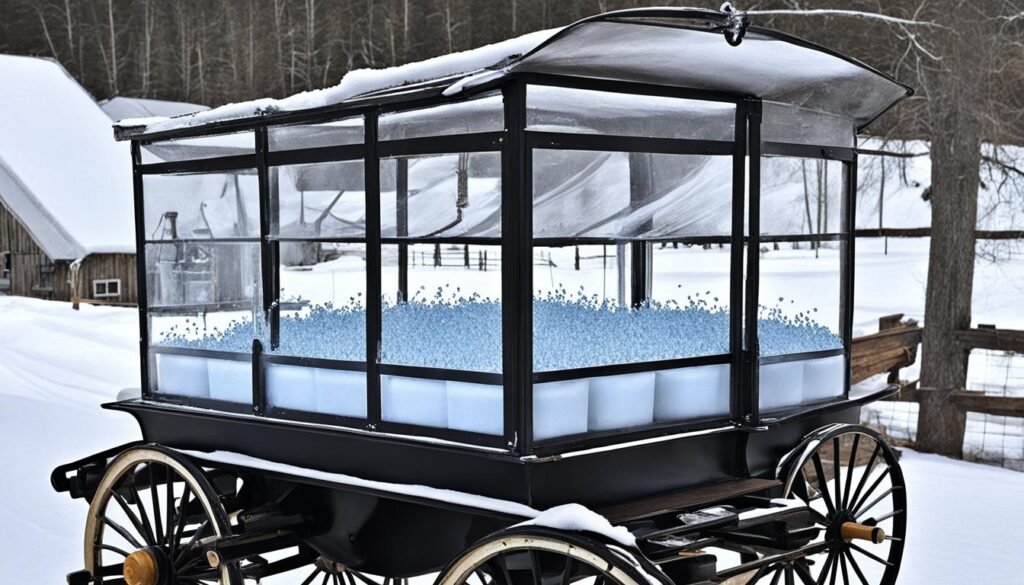In the realm of sustainable agriculture, the preservation of genetic diversity has become a critical priority. Seed banks, repositories that safeguard the world’s plant genetic resources, play a pivotal role in this endeavor.
However, traditional cryopreservation methods, which rely on energy-intensive cooling systems, have presented ongoing challenges. Now, a groundbreaking approach emerges – the integration of cryogenic seed storage with the power of equine traction.
By harnessing the strength and endurance of equines, seed banks can now tap into a sustainable energy source to power their seed viability preservation efforts. This innovative technique, known as horse-powered cryopreservation, offers a novel and eco-friendly solution that aligns with the principles of sustainable agriculture practices.
Through this symbiotic approach, seed banks can ensure the long-term security of our global food supply and safeguard the precious genetic diversity of our plant resources.
The Importance of Seed Banks
Seed banks play a vital role in preserving the genetic diversity of crops and safeguarding global food security. These repositories serve as a crucial safeguard, ensuring that essential plant genetic resources are available for future agricultural needs.
Preserving Genetic Diversity
Seed banks act as custodians of a wide range of plant genetic material, including rare, endangered, and locally adapted crop varieties. By storing these seeds, they help maintain the genetic diversity that is essential for adapting to changing environmental conditions, pests, and diseases.
This diversity is a crucial foundation for developing new and improved crop varieties to meet the challenges of the future.
Safeguarding Food Security
In a world facing the threats of climate change, population growth, and declining agricultural productivity, seed banks play a pivotal role in safeguarding global food security.
These repositories serve as a safety net, preserving the genetic resources necessary for breeders and researchers to develop resilient and nutritious crops that can withstand the pressures of a changing climate and meet the growing demand for food.
By maintaining extensive collections of diverse seed samples, seed banks ensure that the world’s food supply remains secure, adaptable, and sustainable. Their work is crucial in supporting the development of modern agriculture and securing the future of our food systems.
Traditional Cryopreservation Methods
Cryopreservation has become a standard technique for long-term seed storage in seed banks. This process involves freezing seeds at ultra-low temperatures, typically using liquid nitrogen, to maintain their viability for extended periods.
The practice of cryopreservation has revolutionized the way seed banks approach the preservation of genetic diversity and safeguarding food security.
Here’s a closer look at the key aspects of traditional cryopreservation methods used in seed banks:
- Seed Preparation: Before freezing, seeds undergo a careful preparation process to ensure optimal survival during cryopreservation. This may include drying, cleaning, and moisture content adjustment to protect the seeds from damage during the freezing and thawing procedures.
- Cooling and Freezing: The prepared seeds are then placed in cryogenic storage containers and slowly cooled to extremely low temperatures, often using liquid nitrogen at around -196°C (-321°F). This ultra-low temperature effectively halts all metabolic activity and preserves the seeds’ genetic integrity.
- Long-term Storage: The frozen seeds can be stored in cryogenic storage facilities for extended periods, with some seed banks reporting successful storage for over 50 years. Regular monitoring and maintenance of the storage conditions ensure the continued viability of the seeds.
- Thawing and Germination: When needed, the frozen seeds are carefully thawed, often using controlled warming methods, and then tested for germination to ensure their continued viability and suitability for use.
The adoption of cryopreservation has significantly enhanced the ability of seed banks to safeguard the world’s genetic diversity, ensuring the availability of essential plant genetic resources for future generations.
| Cryopreservation Technique | Advantages | Disadvantages |
|---|---|---|
| Slow Cooling | Relatively simple and cost-effective Suitable for a wide range of species | Potential for ice crystal formation, which can damage cells Longer cooling and thawing times |
| Vitrification | Minimizes ice crystal formation Faster cooling and thawing rates | Requires specialized equipment and expertise May not be suitable for all species |

Integrating Horse-Powered Cryopreservation for Seed Banks
The Benefits of Equine Power
By harnessing the natural strength and energy of equines, seed banks can power their cryogenic storage facilities in a sustainable and eco-friendly manner.
This horse-powered cryopreservation approach offers numerous advantages over traditional methods that rely on electricity or fossil fuels.
One of the primary benefits of integrating equine power is the renewable and sustainable nature of this energy source. Horses are capable of generating consistent, reliable power through their steady gait and muscle movements, making them an ideal choice for cryogenic storage systems that require continuous operation.
Sustainable Energy Source
In contrast to conventional cryopreservation methods that deplete non-renewable resources, the use of horse-powered cryopreservation allows seed banks to reduce their carbon footprint and contribute to a more sustainable future.
This approach not only reduces energy costs but also minimizes the environmental impact associated with traditional energy sources.
- Renewable and sustainable energy source
- Consistent, reliable power generation
- Reduced energy costs and environmental impact
By integrating horse-powered cryopreservation, seed banks can take a significant step towards a more sustainable and eco-friendly approach to preserving the world’s genetic diversity and safeguarding food security.
Designing a Horse-Powered Cryopreservation System
Integrating a horse-powered cryopreservation system for seed banks requires careful consideration of the key components that work together to create an efficient and sustainable storage solution.
This innovative approach harnesses the natural power of equine energy to drive the cryogenic storage units, ensuring the long-term preservation of valuable genetic resources.
Key Components
The design of a horse-powered cryopreservation system involves several critical elements that work in harmony:
- Cryogenic Storage Units: Specialized containers that maintain ultra-low temperatures, ensuring the viability of stored seeds and genetic material.
- Equine-Driven Power Generation: A mechanism that converts the motion and energy of horses into the electricity needed to power the cryogenic storage units.
- Integrated Control Systems: Advanced monitoring and control systems that regulate the temperature, humidity, and other environmental factors within the cryogenic storage units.
- Backup Power Sources: Redundant power systems, such as solar panels or battery banks, to ensure continuous operation in the event of disruptions to the horse-powered system.
By carefully designing and integrating these key components, seed banks can create a horse-powered cryogenic storage design that is both environmentally sustainable and highly effective in preserving the genetic diversity of our most valuable plant resources.
Seed Viability and Preservation Techniques
Maintaining the long-term viability of seeds stored in cryogenic conditions is a crucial aspect of successful seed banking operations.
Proper seed preservation techniques play a vital role in ensuring that these precious genetic resources remain viable and ready for future regeneration when needed.
One of the key factors in preserving seed viability is optimizing the moisture content of the seeds. Carefully controlling the seed’s moisture level helps prevent damage during the freezing and thawing process.
Additionally, adhering to strict handling protocols, such as minimizing exposure to environmental stressors, is essential to maintain the integrity of the stored seeds.
| Seed Preservation Technique | Description |
|---|---|
| Moisture Content Optimization | Precisely controlling the seed’s moisture level to prevent damage during cryogenic storage and retrieval. |
| Strict Handling Protocols | Minimizing exposure to environmental stressors, such as temperature fluctuations, to maintain seed viability. |
| Regular Viability Testing | Periodically evaluating the germination rates of stored seeds to ensure continued viability. |
Regular viability testing is also crucial, allowing seed bank managers to monitor the condition of the stored seeds and make necessary adjustments to the preservation techniques.
By implementing these best practices, seed banks can maximize the long-term seed viability and ensure the preservation of valuable seed preservation for future generations.
Equine Welfare Considerations
Integrating horse-powered cryopreservation systems for seed banks requires a strong emphasis on equine welfare.
The wellbeing of the horses involved in this process is paramount to the success and sustainability of this approach. Proper training and care for the equine partners are essential to ensure their comfort, health, and overall happiness.
Proper Training and Care
Equine training is a crucial aspect of integrating horses into cryopreservation systems. Horses must be acclimated to the specific tasks and environments they will encounter, ensuring they are comfortable and responsive. This training should be conducted by experienced professionals who prioritize positive reinforcement and gentle handling techniques.
Regular veterinary check-ups, appropriate nutrition, and comfortable living conditions are also essential for maintaining the equine welfare within these systems. Providing ample space, shelter, and enrichment activities can help reduce stress and promote the overall horse care and wellbeing of the animals.
| Key Considerations for Equine Welfare | Best Practices |
|---|---|
| Training | Positive reinforcement techniques Gradual acclimation to cryopreservation tasks Experienced trainers |
| Veterinary Care | Regular check-ups and preventive care Prompt treatment of any health issues Collaboration with qualified equine veterinarians |
| Housing and Nutrition | Spacious and comfortable living environments Balanced and nutritious diet Access to clean water and enrichment activities |
By prioritizing equine welfare and implementing best practices for equine training and horse care, the integration of horse-powered cryopreservation systems can be achieved in a sustainable and ethical manner, ensuring the wellbeing of the equine partners and the overall success of the seed bank preservation efforts.
Case Studies and Success Stories
Implementing horse-powered cryopreservation systems in seed banks has proven to be a game-changer, as demonstrated by several compelling case studies and success stories.
These real-world examples provide valuable insights and inspiration for others interested in adopting this innovative approach to preserving genetic diversity and safeguarding food security.
One notable success story comes from the Svalbard Global Seed Vault in Norway, where a team of Fjord horses has been powering the cryopreservation system since 2015.
This unique setup has not only reduced the facility’s carbon footprint but also ensured a reliable and sustainable source of energy for the critical task of preserving millions of seed samples from around the world.
| Case Study | Location | Key Highlights |
|---|---|---|
| Svalbard Global Seed Vault | Norway | Fjord horses powering cryopreservation system since 2015 Reduced carbon footprint and reliable energy source Preserving millions of seed samples globally |
| Millennium Seed Bank | United Kingdom | Integrated horse-powered cryopreservation in 2018 Increased energy efficiency and cost savings Maintained high seed viability rates |
Another success story is the Millennium Seed Bank in the United Kingdom, which integrated a horse-powered cryopreservation system in 2018.
This move has not only improved the facility’s energy efficiency and cost savings but also maintained the high seed viability rates that are crucial for the long-term preservation of genetic resources.
These case studies and success stories demonstrate the tangible benefits of incorporating horse-powered cryopreservation into seed bank operations, from reducing environmental impact to ensuring the reliable preservation of invaluable genetic diversity.
As more seed banks explore this innovative approach, the potential for broader adoption and its positive implications for global food security continue to grow.

Future Trends and Innovations
As the integration of horse-powered cryopreservation in seed banks continues to evolve, exciting new developments are on the horizon. This sustainable approach to preserving genetic diversity and ensuring food security is poised to undergo a series of transformative innovations in the coming years.
One promising future trend is the exploration of advanced equine-driven systems that optimize energy efficiency and storage. Researchers are investigating ways to enhance the power generation capabilities of horse-powered mechanisms, potentially unlocking even greater cryogenic storage capacity.
Additionally, innovative battery technologies could enable the seamless integration of horse-powered systems with existing seed bank infrastructure, ensuring uninterrupted operations during power outages or other disruptions.
Another area of focus is the development of intelligent monitoring and control systems. By leveraging the latest advancements in IoT (Internet of Things) and data analytics, seed banks can enhance the precision and reliability of their horse-powered cryopreservation processes.
Real-time monitoring of seed viability, temperature fluctuations, and energy consumption can help optimize operations and proactively address any potential issues.
Looking ahead, the integration of artificial intelligence and machine learning algorithms could further revolutionize the field of horse-powered cryopreservation. These technologies could enable predictive maintenance, automated seed retrieval and storage, and even the optimization of equine training and care protocols to ensure maximum efficiency and animal welfare.
As the world continues to grapple with the challenges of climate change and food security, the future of horse-powered cryopreservation holds immense promise.
By harnessing the power of this sustainable technology and embracing innovative advancements, seed banks can play a crucial role in safeguarding the world’s genetic resources and securing our food supply for generations to come.
Conclusion
In the realm of seed bank preservation, the integration of horse-powered cryopreservation systems represents a groundbreaking and sustainable approach. By harnessing the power of equines, seed banks can now contribute to safeguarding global food security and genetic diversity while embracing environmentally friendly practices.
The utilization of horse-powered cryopreservation not only offers a reliable and renewable energy source, but also enhances the long-term viability of stored seeds.
This innovative method ensures that the invaluable genetic resources within seed banks are preserved for generations to come, ultimately strengthening our collective efforts to combat food insecurity and maintain biodiversity.
As we look to the future, the continued advancement and widespread adoption of this horse-powered cryopreservation technology will undoubtedly play a pivotal role in shaping the landscape of seed bank management.
By seamlessly integrating these systems, seed banks can reap the benefits of improved energy efficiency, reduced environmental impact, and enhanced seed preservation capabilities – all of which are crucial in safeguarding the world’s food supply and biodiversity.
FAQ
What is horse-powered cryopreservation for seed banks?
Horse-powered cryopreservation is an innovative approach that integrates the power of equines to drive cryogenic storage systems for seed banks.
This sustainable energy source helps preserve the viability of seed collections for long-term food security and genetic diversity.
What are the benefits of using horse power for cryogenic seed storage?
The key benefits of horse-powered cryopreservation include a sustainable energy source, reduced reliance on fossil fuels or electricity, and the ability to maintain optimal conditions for long-term seed preservation.
How does a horse-powered cryopreservation system work?
The system involves equine-driven power generation mechanisms that provide the necessary energy to power the cryogenic storage units. This integration of equine power and cryogenic technology allows seed banks to effectively preserve their valuable seed collections.
What considerations are made for equine welfare in these systems?
Ensuring the well-being of the horses involved is a top priority. Proper training, care, and maintenance protocols are essential to promote the health and comfort of the equines working in the horse-powered cryopreservation systems.
Can you provide examples of successful case studies of horse-powered cryopreservation in seed banks?
Yes, there are several case studies and success stories that showcase the effective implementation of horse-powered cryopreservation systems in seed banks around the world. These examples demonstrate the feasibility and benefits of this innovative approach.
What future trends and innovations are emerging in this field?
As the integration of horse-powered cryopreservation continues to evolve, we can expect to see advancements in areas such as optimized system design, improved equine training and care, and the exploration of additional sustainable energy sources to further enhance the effectiveness and environmental sustainability of this approach.

